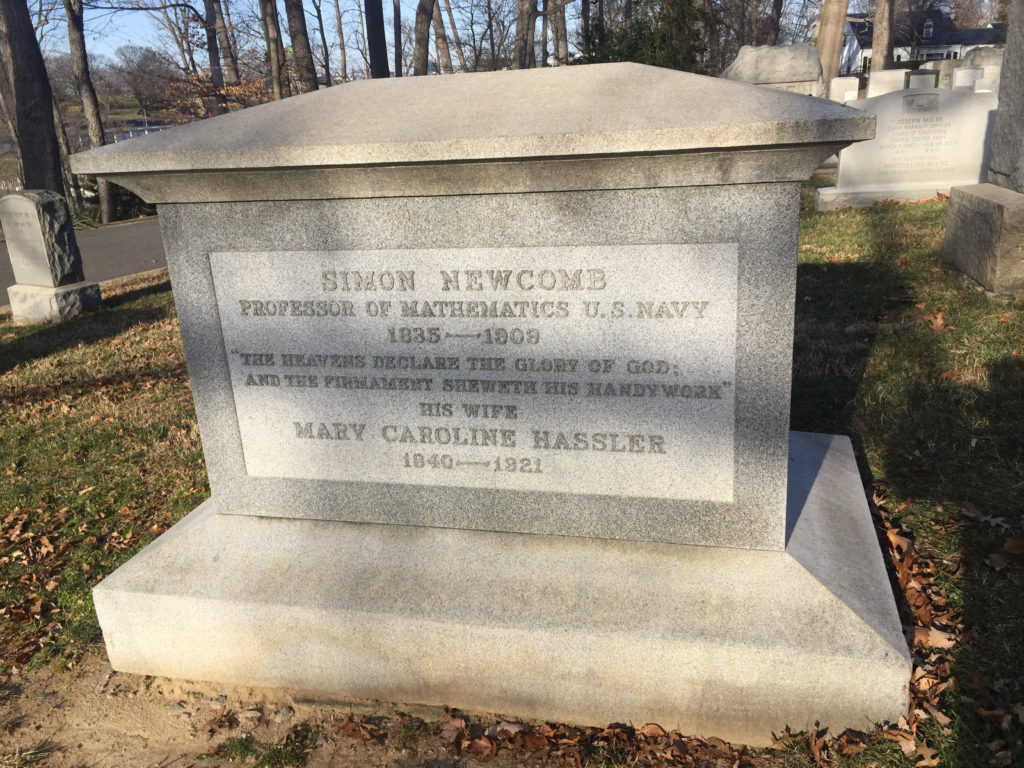Erik Visits an American Grave, Part 862
This is the grave of Simon Newcomb.

Born in 1835 in Wallace, Nova Scotia, Newcomb was taught at home by his father, an itinerant teacher and not overly successful guy. As a teen, his father apprenticed Newcomb out to a herbalist in New Brunswick. But the guy was a total quack and Newcomb realized that pretty fast. Evidently already interested in science and medicine, he had no interest in working for a charlatan. So one day, he broke the apprenticeship and walked away. He headed south to Calais, Maine. By this time, his father was in Salem, Massachusetts teaching at a school. He got on a ship and headed to Salem. Meeting his father there, they decided to go to Maryland. Both Newcombs taught there, Simon at a couple of rural schools. He was learning as much as he could at this time, but his training was very much that of the autodidact. But he became a private tutor outside Washington, D.C. in 1856. This helped him with his studies, as he frequented the Library of Congress and other institutions of learning in the city. He also got to know the local scientific community. By this time, his interests were primarily in mathematics and astronomy. Finally, he went to the Lawrence Scientific School at Harvard for a time, getting some real training.
By 1861, Newcomb’s training in mathematics had extra value. A lot of the military instructors in math had committed treason in defense of slavery. The Army needed capable teachers. So Newcomb got a job as a mathematics instructor at the U.S. Naval Observatory in Washington. In 1863, he married Mary Hassler, daughter of a leading Navy surgeon named Charles Augustus Hassler. She is of course buried here as well. While teaching there, he started doing serious astronomical research. This was pretty practical at first. He wanted to study the position of planets for help in navigation of ships. But then he became interested in planetary motion more generally. He went to Paris for further study on the issue in 1870, knowing that much of the extant research on the issue was incorrect. However, his research trip ran straight into the Paris Commune, which he had to flee. But he was able to revise old planetary motion tables based upon what he had done.
After he returned to the U.S., Harvard offered Newcomb their director of its observatory, but he had decided that he wanted to focus more on math than astronomy going forward, or at least more on math than abstract observation. He became the head of the National Almanac Office, where he continued his work on recalculating astronomical charts that he now rightly believed were often flawed. By the 1890s, his charts were seen as the international standard. Newcomb’s other experiments included attempting to measure the speed of light, an issue on which he made advances, even if it wasn’t the final word. He also expanded on the principle of the wobbly Earth known as Chandler’s wobble to measure the elasticity of the planet. He also wrote on economic questions, well enough that he influenced John Maynard Keynes. He had commitment to science education and wrote a few popular science book. He also wrote a science fiction novel titled His Wisdom the Defender, which he published in 1900. He learned several languages and also became a leading mountain climber of the era. So, an interesting guy. Less successfully, he theorized that it would be impossible for humans to fly, though cheerfully ceded the point after hearing about the Wright Brothers, though that didn’t happen until 1908, as they weren’t that famous immediately after 1903 and he had never heard of the pair for five years.
At Harvard. Newcomb studied math with Benjamin Peirce, father of the philosopher Charles Sanders Peirce. Evidently, Newcomb hated Charles. Peirce always had trouble getting jobs and especially holding jobs. In 1884, Newcomb got a job as a professor of mathematics and astronomy at Johns Hopkins. Peirce was up for a job at Hopkins. Newcomb fought for the university to not hire Peirce. He also sabotaged Peirce’s grantwriting, influencing Carnegie Institute trustees to deny the philosopher a grant that had support from people such as Theodore Roosevelt and William James. Peirce himself was notorious both for being an extremely difficult person to deal with and for flouting Victorian sexual norms by having affairs with women. Either or both could have been at the root of Newcomb’s hatred. No real idea who was more at fault in this conflict, but one can’t really say Newcomb acted all that professionally in it.
Today, there is a crater on both the Moon and Mars named for him. He had written on the moon. In fact, his last book, published in 1912, was his second discussion of his Moon research. But this was published after his death, which happened in 1909. He was 74 years old.
Simon Newcomb is buried on the confiscated lands of the traitor Lee, Arlington National Cemetery, Arlington, Virginia.
This grave visit was sponsored by LGM reader donations. Thanks! If you would like this series to visit other astronomers, you can donate to cover the required expenses here. Carl Sagan is in Ithaca, New York and Henrietta Swan Levitt is in Cambridge, Massachusetts. Previous posts in this series are archived here.


